Best Barefoot Shoes for Beginners

As your barefoot shoe guide, I’m here to help you find your first pair of barefoot shoes. This list of the best barefoot shoes for beginners breaks them out into different categories like most affordable, most cushion, widest options, etc to help you find the best fit for you.
What makes a good shoe for someone new to barefoot shoes?
If you asked ten different people for the best barefoot shoe for a beginner, you could get ten different answers. The best barefoot shoe will depend a lot about your feet, your body, your personal preferences, and your budget. However, most of us have adapted to a few features of conventional shoes, which is why it can be helpful to start with a transitional barefoot or minimalist shoe.
So, what have we gotten used to in conventional shoes?
Cushion— This is the biggie when it comes to transitioning to minimalist and barefoot shoes. Reducing the amount of cushion in our shoes is usually what takes people the longest to adjust to.
Unfortunately, the amount of cushion in shoes seems to be trending in the wrong direction, with companies designing shoes with more and more cushion. Even a fairly low cushion running shoe from a traditional brand will have about 20mm of cushion in the heel.
Because we are used to having so much cushion in our shoes, we may not be very aware just how hard we are slamming our heels down into the pavement when we walk or run. Transitioning to shoes with thinner soles can be a big wake up call. That’s why most of the options I’m listing here as the best beginner barefoot shoes have a bit more cushion than your true barefoot shoe, but still a lot less than most conventional shoes.
When I talk about the amount of cushion in a shoe, I’ll sometimes reference the total stack height, which is the thickness of the outsole plus the insole. Sometimes the insole is removable, so you can take it out to reduce the amount of cushion or replace it with a thicker insole for more cushion.
Arch Support — Getting rid of arch support can be another big adjustment. Part of it is the mental hurdle of accepting that healthy feet do not need support and function optimally without it.
Many shoes have stiff arch support, which limits the way and amount your foot can move, and usually leads to a weakened arch. Just like any muscle, it takes time to build the strength back up when we take the support away.
Heel Drop — Most conventional shoes are heeled, even if we don’t think of them in that way. It’s obvious to see the heel in high heels and dress shoes, but even tennis shoes have a drop from heel to toe with more cushion in the heel. Over the long-term, this can shorten the Achilles tendon, so you may feel a bit different when switching to a flat shoe. A zero drop shoe encourages a more natural walking and running gait, including a forefoot or midfoot strike when running.
Toe Spring — Toe springs are another common feature in conventional shoes. It’s where the toe of the shoe curves upward. This is usually to combat a more rigid sole, and make it easier for our foot to roll through while walking.

What are barefoot shoes?
The terminology can sometimes confuse people, especially as “barefoot shoe” is kind of an oxymoron. Barefoot shoes are essentially shoes that let you move and walk naturally, as if you were barefoot. Some people like to separate the range of barefoot shoes into “true” barefoot shoes (those with a very thin soles), and call the shoes with thicker soles or more cushion “minimalist shoes” or “transitional barefoot” shoes.
Most of the shoes we’ll be talking about here are in that “transitional barefoot” shoe bucket as they tend to have thicker soles with more cushion. So basically, they’re a barefoot shoe with cushion. They may also have a few other features that aren’t in a typical barefoot shoe, like a small heel drop, or a toe spring.
Here’s what to look for in your barefoot shoes:
Wide toe box — The toe box should be wide, allowing your toes to naturally splay. This means that your big toe can lie straight, so the toe box is either straight or splay out at the big toe. This is one of the most noticeable differences between a barefoot shoe and a conventional shoe, which has a tapered and almost symmetrical toe box.
Flat — The sole of the shoe should be flat, meaning no heels or significant upturn at the toe (called a toe spring). Most conventional shoes have a significant heel drop, so it can be an adjustment to get used to standing flat again. Some transitional barefoot shoes have a small heel drop (like 2 to 4mm) or a slight toe spring.
Flexible — Again, the focus here is allowing the foot to function naturally, so the shoe including the sole should be flexible and allow the foot to easily bend and move.
Thin — A barefoot shoes is typically thin, which allows for flexibility, ground feel and natural movement. Since the lack of cushion can be one of the hardest things about switching, this list of barefoot shoes for beginners is essentially a list of barefoot shoes with cushion.
Tips for transitioning to barefoot shoes
- Take it at your own pace. The most important thing in this process is to listen to your feet and body.
- Start by spending time barefoot each day. 30 minutes is a great place to start.
- Exercise and move your feet!
- Check your walking gait. Many of us have adapted our walking patterns based on the shoes we wear, so examine and correct your walking gait if needed.
- Measure your feet before making any purchases (read these instructions here). Most barefoot shoes are still only available from online retailers, and it’s best to understand a bit more about your feet including your measurements before you start looking at barefoot shoes. You’ll have the most success in transitioning to barefoot shoes if you find a pair that fit your feet well.
- Start by wearing your minimalist or barefoot shoes for a few hours a day. If this is too much at first, then scale it back. If your feet and body are comfortable with a few hours, add more.
- Consider adding a thin, flat insole to your barefoot shoes during your transition if you feel like you need more cushion. Instead of buying a pair of shoes with thicker soles (like Altras), you can opt for a thinner soled shoe and adding an insole that is a few millimeters thick for the extra cushion. That way, you can simply remove the insole when you’re comfortable with less cushion instead of having to buy a whole new pair of shoes. Many shoe brands sell insoles or provide them as part of the purchase. Several brands make insoles specifically for transitioning to barefoot shoes. See a list of insole options here.
Best Barefoot Shoes for Beginners
I. Most Affordable Barefoot Shoes for Beginners
Saguaro Shoes
Sizes EU24 – 48 | $35+ | Free shipping | KELLY15 for 15% off

Saguaro Shoes is another brand that’s a practical place to start thanks to their moderately cushioned, budget-friendly shoes. Saguaro offers a wide range of minimalist footwear for all ages, from toddlers to adults. Their full line includes casual sneakers, athletic shoes, boots, water shoes, and rain boots. The flexible rubber soles are around 6mm, plus a 3mm insole, which offers some cushion as your feet adjust to a more minimalist feel.
Read the full review of Saguaro Shoes.
WHITIN Shoes
Sizes Kid’s – Men’s US 13 | $40+ | Free shipping and returns on Amazon

WHITIN shoes are affordable, comfortable, and hold up well. The high cost of barefoot shoes is often one of the biggest barriers for people trying them out, so I know how important it is to have affordable options. I could give you all the studies and statistics about how barefoot shoes are better for your feet and body, but feeling the difference is where the real conversion happens. So if you can spare $40 on a pair of shoes, it can make a world of difference.
WHITIN shoes on Amazon are a great introduction to barefoot shoes due to their affordability, accessibility on Amazon and free shipping and free returns. WHITIN shoes have a wide roomy toe box and flexible sole. The sole appears flat, though they do have a slight toe spring and small heel raise in the insole.
I’ve had so many people follow up to tell me how much they love their WHITIN shoes as their first pair of barefoot shoes several months after they’ve purchased them. I’ve had several family members purchase them, and they’re still loving them after 6+ months of almost daily use. They have a few different styles of sneakers and a casual shoe that looks like Hey Dudes.
When you’re shopping WHITIN shoes, make sure you’re on their “Wide Barefoot” tab. They also have “Barefoot” tab, but most of these shoes look closer to conventionally narrow shoes. The only style I would consider on the regular “barefoot” tab is their trail runner.
There are several other brands on Amazon that are good barefoot shoes for beginners: Joomra, which is very similar to WHITIN, and Saguaro.
WHITIN offers a handful of casual minimalist styles, as well as trail runners and zero-drop, wide toe box running shoes with cushion. Get all the info in this full brand review of WHITIN shoes.
Find a more complete list of affordable barefoot shoes here, as well as tips like when to shop for sales and where to buy gently used shoes.
II. Best Overall Barefoot Shoes for Beginners
Lems Shoes
Sizes Women’s US 6 – Men’s US 13 | $110+ | Stack Height start at 12.5mm

Lems were one of my first barefoot shoes. They were a good introduction to barefoot shoes as they have a wide comfy toe box and a little bit thicker soles with some cushion. The soles are made with air-injection rubber, so even with a thicker stack height, they’re still very lightweight.
Lems also offers a wide range of styles. Any one of them can be a great option depending on what you need, but the Primal 2s or Primal Zen are an athletic/casual shoe that can fill a lot of needs if you’re just looking to start off with one shoe you can wear often. The Primal 2s have a total stack height of 12.5mm, and the Primal Zen are slightly thicker at 14mm.
The Boulder Boots are a popular option for winter or those that want a comfortable work boot, the Nine2Five is a men’s business casual shoe, and there are plenty of casual and hiking options too.
See this full brand review of Lems shoes, including mini reviews on individual styles and tips on fit & sizing.
III. Most Cushion in Foot-Friendly Shoes
Altra
Sizes Women’s US 6 – Men’s US 13 | $130+ | Stack Height starting at 25mm

I know cushion can be one of the hardest things to give up, so here is an option that has a foot-shaped toe box and zero drop sole while still providing cushion when you’re first transitioning to barefoot shoes.
Altra shoes come in three different foot shape fits (essentially toe box widths). I would stick to their Original and Standard footshape fits. You can also get both of these shapes in a wide fit, which increases the overall width of the shoe, but doesn’t mean an additional width increase in the toe box.
All Altras are zero drop, but they do have a noticeable toe spring.
Altra shoes have varying amounts of cushion, and the least cushioned start around 25mm. Altra seems to be putting out narrower and more cushioned options lately, so I would keep that in mind as you browse their options. Many people that work long shifts on hard flooring (like nurses and other healthcare workers) often cite Altras as one of their favorites.
The Altra Lone Peaks are a great trail running shoe with 25mm stack height in the Original (widest) foot shape fit. The Torins are a good road running or everyday shoe with a 28 mm stack height in the Standard (medium) footshape fit. Both of these styles offer the wide width option.
Topo Athletic
Sizes Women’s US 6 – Men’s US 13 | $120+ | Stack Height starting at 25mm


Topo Athletic is another running shoe company that offers wide toe boxes and low or zero drop shoes. Similar to Altra, they are not a barefoot shoe company though, so they still have a lot of cushion.
The zero drop shoes styles include the Magnifly4 and the St-4. Most of Topo Athletic’s other shoes have a slight heel drop of 5mm. All of the shoes have a toe spring.
The Magnifly4 is one of Topo’s least cushioned styles with a stack height of 25 mm cushion. The cushioning just goes up from there, so I would recommend trying their least cushioned models if you are trying to transition to barefoot shoes. Even though it has a similar amount of cushion to the Altras, I would describe the Topo cushion as less soft and springy. If you like something that feels a little more solid under your feet, Topo may be the better choice.
Dolfie Paradise
EU36 – 47 | $170+ | | Code KELLYDP10 for 10% off | Stack Height 9mm to 14mm
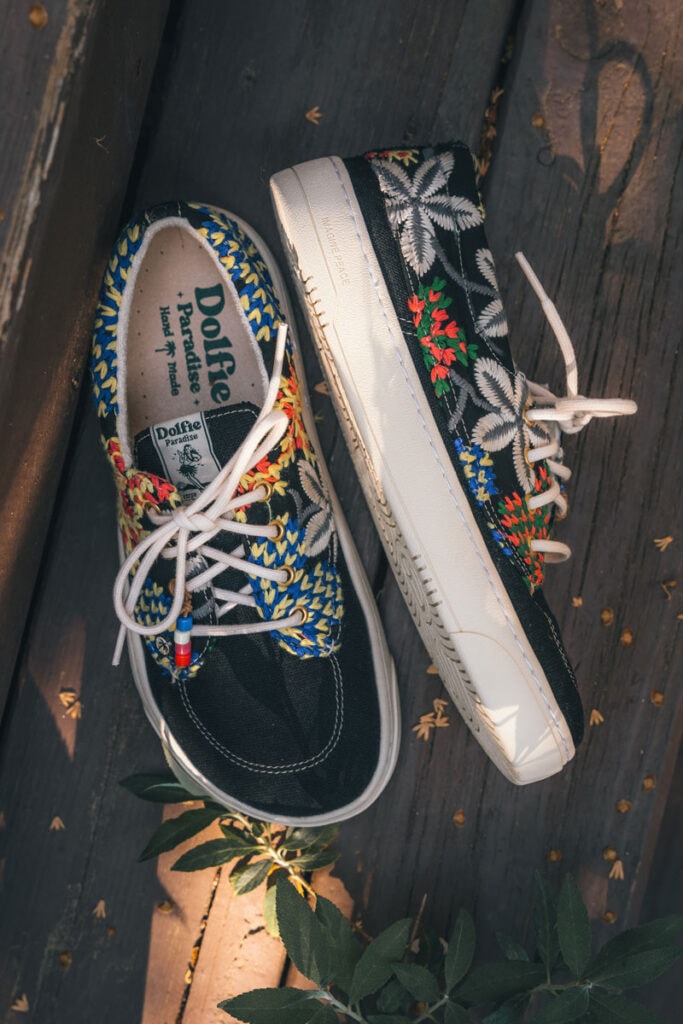
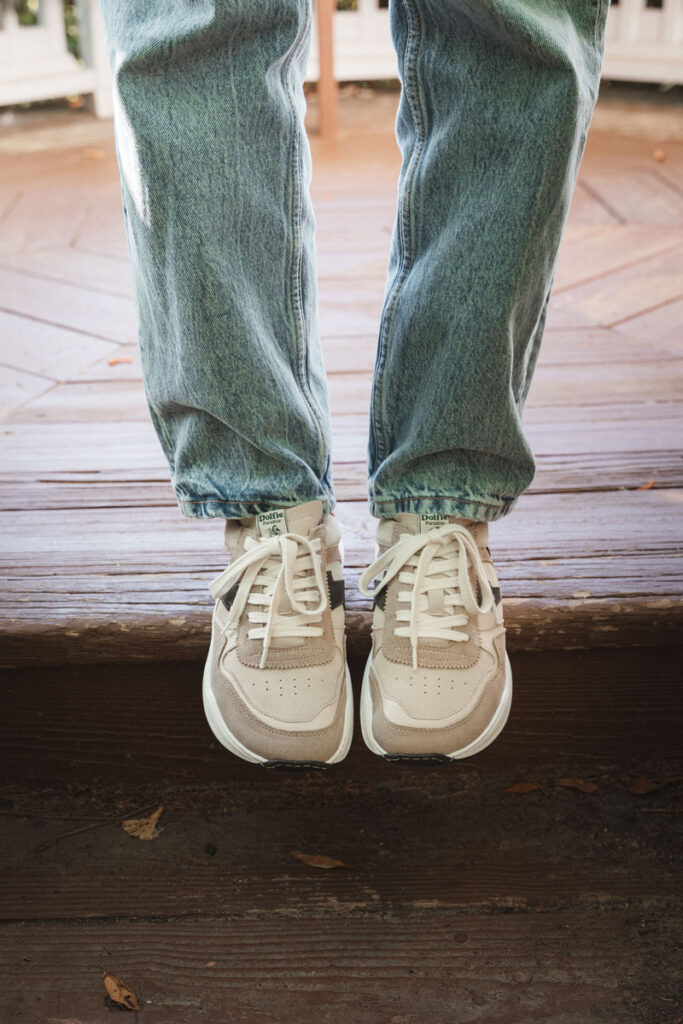
Dolfie Paradise is making some of the best-looking wide toe box shoes with moderate cushion right now. Each pair comes with two insoles (3mm and 8mm), so you can choose between more ground feel or a more cushioned, beginner-friendly option. My personal favorites are the Supersonic sneakers—hands down the coolest “dad sneaker” style I’ve seen—the MC5, which go with everything, and the Dylans, which have such a fun, laid-back vibe. The quality on every pair feels exceptional, and the leather is truly premium. If you’re new to barefoot shoes and want something stylish and comfortable, Dolfie Paradise is one of the best places to start.
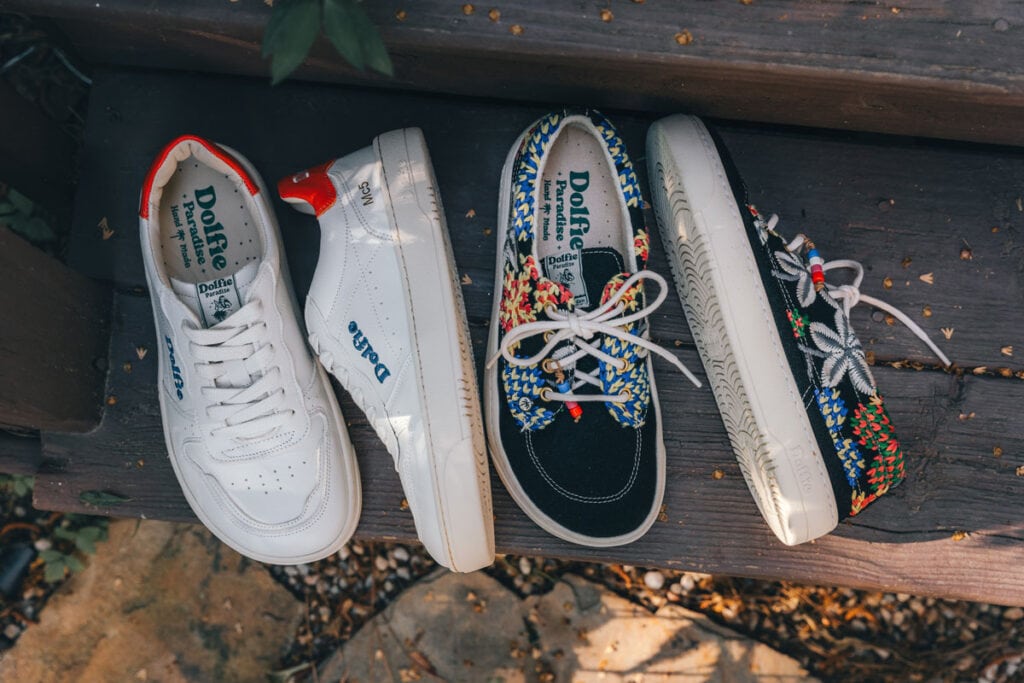
Flux Adapt Runner
Sizes Women’s US 5.5 – Men’s US 14 | $140 | Stack Height 30mm


The Flux Adapt Runner is the least barefoot option on this list, but they are zero-drop with a wide, anatomical toe box. The sole is fairly stiff with 30 mm of cushioning and a significant toe spring, which means they provide a softer, less natural feel compared to true barefoot shoes. This design can impact the walking and running gait (especially the stiffness of the sole and the toe spring), but it may be beneficial for individuals who require more time or gradual assistance during the transition to minimalist footwear.
IV. Best Style in Barefoot Shoes for Beginners
A lot of barefoot shoes tend to have pretty simple, basic styling. I personally like this, but if you’re looking for something that’s a little more trendy, then there are a few brands that have really made an effort to create stylish barefoot shoes.
Barebarics
Faux Leather | EU 36- 47 | $139+ | KELLY5 for 5% off | Stack Height 10mm
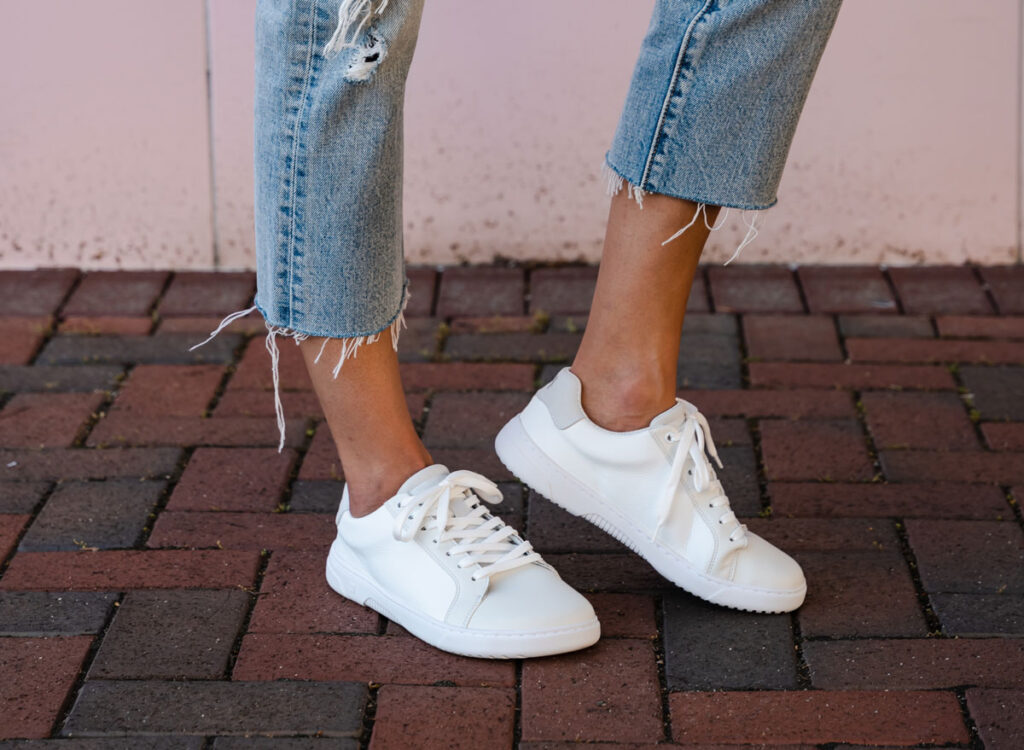
Barebarics focuses on transitional barefoot or minimalist shoes with a more urban design. They’re the sister brand of the popular barefoot brand BeLenka. As Barebarics are specifically designed for a more urban setting, they do have somewhat thicker soles. The 4mm sole plus lugs plus insole leads to a total stack height of 10mm. Many barefoot shoes tend to be very simple in their design, and Barebarics does offer a bit more flair and interesting elements.
V. Best Extra Wide Option
Bohempia
Vegan hemp uppers | 7.5 mm stack height | Extra wide version | Starting at €115 | Code KELLY10 for 10% off

Bohempia’s barefoot shoes are already pretty generous in width and volume, but they also have an extra wide version. For example, the size EU40 has a width of 9.6cm on the standard barefoot shoes, and a width of 10.5 cm on the wide width barefoot 5shoes.
The outsoles are 3.5mm and the insoles are 4mm, so they have moderate cushion to help someone that’s new to barefoot shoes. Because they also tend to have more volume (or space from top to bottom), then can accommodate a thicker insole for most people. If you want more than the 4mm insole that comes with the shoe, you can swap them out for thicker ones. True North Soles specifically makes thicker insoles for barefoot shoes. You can read more about these insoles here.
VI. Runners-up for Best Barefoot Shoes for Beginners
The best barefoot shoe for you as a beginner is going to be the one that fits your feet and needs the best. Here are a few more options that you may find are a better fit for you.
Bahé
Mesh uppers | EU36 – 47 | $175 during preorder Aug 1 – 13 | Code BAREFOOTGUIDE for 10% off | Stack height 10mm plus 3mm removable insole

Bahé is not a new brand, but they are new to the barefoot shoe world. They first created a grounded running shoe, and then updated their design to make an amazing minimalist shoe with a wide toe box and zero-drop sole. You can currently pre-order the shoes, with delivery starting in December 2023.
The toe box is foot-shaped and very roomy, but the design elements don’t make it look noticeably wide. I can comfortably wear these with toe spacers.
The sole is flat and flexible. At a 10mm stack height, it hits that sweet spot of not too thick and not too thin. These are designed as running shoes, but are super comfortable to wear for everyday, and are especially great for those new to barefoot shoes. The shoes come with a removable 3mm insole. You can keep them in for extra cushion, or take them out to add more volume and ground feel.
I opted for an EU38 based on my 23.3cm foot measurement and found them to fit true to size. As someone with a higher instep that tends to prefer shoes with more volume, I found these had enough room, even with the extra insole still in. I think the accommodate medium to wide feet and medium to high volume best.
Origo
Leather, Cactus Leather and Canvas | EU24 – 47 | $78+ | Code KELLY for 10% off | Stack height 6mm

Origo’s everyday sneakers have a 6mm stack height, plus they come with an extra insole to provide. Overall, these shoes fit narrow to medium wide feet best. Origo focuses on using sustainable materials in its barefoot shoes, including in the cotton canvas sneakers. Origo has shoes for both kids and adults, starting at size EU24/Kid’s 8. The adult sizes are a reasonably affordable barefoot shoe option that cost $78 using the . This code also usually stacks on top of sales, so if they are having a sale, you can sometimes get 20% to 30% off.
Icarus
Leather | US Men’s 8 – 13 | $144 | Code KELLY10 for 10% off | Stack height 5 to 16mm

The Ascent sneaker by Icarus Footwear is a beginner minimalist shoe brand that makes a versatile wide toe box sneaker meant for both the gym and casual wear. Since these are designed to be versatile, they can be a great barefoot shoe for beginners as you have one shoe that will work in a variety of situations.
These shoes also make a good option for someone that isn’t yet comfortable with super thin sole and working on transitioning to zero drop. The sneakers have a 5 mm outsole, plus three different insoles to choose from according to your comfort level, including a thicker insole with a heel drop. The stack height ranges from 5mm with no insole up to 16 mm in the heel with the thickest insole. You can start out with the thickest insole that includes a heel drop, then work your way down to the thinner zero drop insoles when you’re comfortable.
Icarus Footwear currently only has larger sizing, but they’re working on smaller women’s sizing soon. They offer free shipping and free returns, and have a pretty impressive “forever guarantee.”
Anatomic
Canvas | EU36 – 45 | $148 | Code KELLY for 10% off | 6m sole plus insole

Anatomic are affordable foot-shaped shoes with a wide toe box. They have a thicker sole than the most barefoot shoes, but they’re still flat and pretty flexible. Styles include casual lace ups, slip-ons, and high tops. They’re available in the US from the online minimalist shoe retailer PedTerra, which offers free shipping and free returns. Take 10% off your order with code KELLY. They’re available worldwide from the retailer Tupsunupsu.



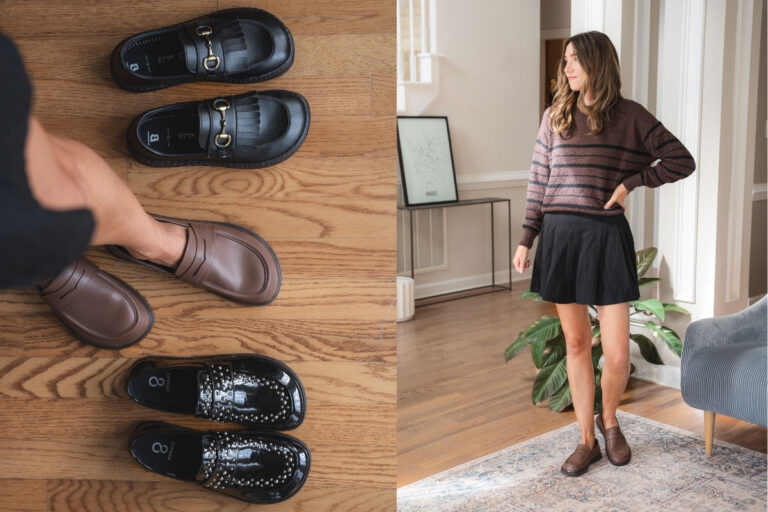



I am on board with the idea and my athletic shoes are mostly in the barefoot wheelhouse, but I just haven’t been able to make the transition with dress shoes. They are so expensive, especially when you consider that most are not leather. I am not paying well over $100 for fabric or vinyl that my feet sweat to death in.